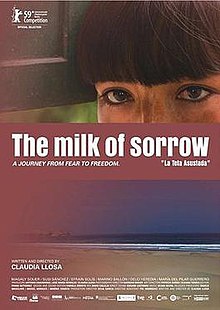The Milk of Sorrow
This whole article should be properly supported reliable sources of information, using the references as part of it. needs additional citations for verification. (September 2010) |
| The Milk of Sorrow | |
|---|---|
 | |
| Directed by | Claudia Llosa |
| Written by | Claudia Llosa |
| Produced by | Antonio Chavarrías Claudia Llosa José Maria Morales |
| Starring | Magaly Solier Susy Sánchez Efrain Solís |
| Cinematography | Natasha Braier |
| Edited by | Frank Gutiérrez |
| Music by | Selma Mutal |
Release dates |
|
Running time | 95 minutes |
| Countries | Template:Film Peru Template:Film Spain |
| Languages | Spanish Quechua |
The Milk of Sorrow (Template:Lang-es, The frightened teat) is a 2009 film by Peruvian director Claudia Llosa and co-produced by Peru and Spain. The film stars Magaly Solier, and addresses the fears of abused women during Peru's recent history. It won the 2009 Golden Bear award and FIPRESCI prize at the Berlin International Film Festival, as well as the award for best movie in the 24 Festival Internacional de Cine de Guadalajara in Mexico. It was nominated for the 82nd Academy Awards for Best Foreign Language Film, becoming the first Peruvian film to be nominated for the award.
Plot summary
Fausta is suffering from a rare disease called the Milk of Sorrow, which is transmitted through the breast milk of pregnant women who were abused or raped (in times of terrorism, in Peru) during or soon after pregnancy. While living in constant fear and confusion due to this "disease", she must face the sudden death of her mother. She chooses to take drastic measures to not follow in her mother's footsteps.
Background
Between 1980 and 1992 Peru experienced a period of very hard violence, particularly in the Andean region, because of the uprising of the Maoist group Sendero Luminoso (Shining Path) and the actions of the paramilitary and state armed forces. By 1990 the conflict finally reached Lima, the capital city of Peru. Claudia Llosa refers in her film to the folk belief that the trauma experienced by women who were raped by members of security force was passed on to their children through the milk from their breasts. Thus, this period of violence continues to affect not only those who experienced it, but also the next generation.
The film is based on the book Entre Prójimos by Kimberly Theidon, Associate Professor at the Department of Anthropology at Harvard University and Director of Praxis, Institute for Social Justice.[1][2] Llosa's work is a psychological as well as sociological approach to the 12 years of conflict, and is critical of the mass rapes used by the army as a strategy of war. In her book, Theidon documents a number of testimonies from women who were raped by as many as thirty men at a time, atrocities that often resulted in pregnancies. Theidon states that "when survivors of sexual violence speak about their experiences, they place a responsibility on their listeners to respond to what they have heard."[3] Llosa's film, too, is an attempt to respond to such testimonies.
Theidon's book will be available in English from University of Pennsylvania Press in Spring 2012. The title is Intimate Enemies: Violence and Reconciliation in Peru.
Filming
Most of the filming locations are set in Manchay, an impoverished suburban area in Pachacamac, south-east of Lima, that indigenous people invaded during 1980s to escape from terrorism, and next to a high-class area from Lima, Cieneguilla.
Critical reception
The film received positive reviews, having a 80% certified "fresh" in Rotten Tomatoes and a critical consensus of:"Claudia Llosa's deliberate pace and abstract storytelling may frustrate some viewers, but there's no denying the visual pleasures soaking in The Milk of Sorrow"; Peter Brunette, from Hollywood Reporter, said "The film is gorgeously shot and contains a plethora of haunting images". Boyd van Hoeij from Variety said that "Peruvian realities and Llosa's light magical realism mesh to create a vivid picture of a society and its problems."
| Review scores | |
|---|---|
| Source | Rating |
| Rotten Tomatoes | |
| IMDB | (6.7/10) |
| Los Angeles Times | |
| Hollywood Reporter | |
| Variety | (7.1/10) |
| New York Post | |
While some Peruvian critics gave the movie negative reviews, the plot and performance were praised by American and European critics.
Awards and nominations
Film Awards
Submissions
- 82nd Academy Awards
- Best Foreign Language Film (nominated)
References
- ^ Interview with Kimberly Theidon by Paola Ugaz from La Terra http://www.terra.com.pe/noticias/articulo/html/act1659267.htm
- ^ http://www.fas.harvard.edu/~anthro/theidon/index.htm
- ^ Theidon, Kimberly Susan. Entre prójimos el conflicto armado interno y la política de la reconciliación en el Perú. Lima, Peru: IEP Ediciones, 2004. Pg 130
